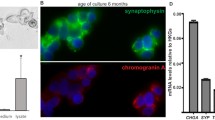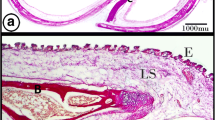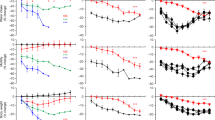Abstract
A morphometric study of argyrophilic Amine Precursor Uptake and Decarboxylase (APUD) cells in airways and intestine of guinea pigs after hypothalamic lesions is reported. APUD cell densities are expressed as APUD cell number/mm of airway or gut perimeter length and as APUD cell/100 epithelial cells. The latter ratio is useful to distinguish generalized epithelial changes from specific alterations in APUD cell densities. Lesions to anterior hypothalamic areas are known to inhibit death due to anaphylactic shock in the guinea pig by a yet to be determined mechanism. It is also known that lesions placed in other hypothalamic nuclei located in the posterior hypothalamus do not interfere with lethal anaphylaxis. Recent quantitative studies of respiratory argyrophilic APUD cells have demonstrated changes in densities of these cells during sensitization and anaphylaxis in the guinea pig, suggesting that they participate in the complex events of anaphylaxis. The present study was performed to determine whether lesions in the anterior and posterior hypothalamus result in changes in APUD cell densities that would suggest a role of the neuroendocrine system in the modulation of lethal anaphylaxis in the guinea pig. The guinea pig has 0.53±2.44 APUD cells/100 nuclei in the larynx, 0.64±0.29 in the trachea, 0.39±0.18 in bronchi, 0.03±0.03 in bronchioles and 10.40±0.70 in the ileum. No significant changes were found in APUD cell densities in animals with hypothalamic lesions when compared to controls, suggesting that mechanisms other than APUD cell hyperplasia or hypoplasia are responsible for the effects of these lesions on lethal anaphylaxis in the guinea pig.
Similar content being viewed by others
References
Becker KL, Geelhoed G (1978) Calcitonin persists following total thyroidectomy. Fed Proc 38:849
Becker KL, Monaghan KG, Silva O (1980) Immunocytochemical localization of calcitonin in Kulchitsky cells of the lung. Arch Pathol Lab Med 104:196–198
Freedman DX, Fenichel G (1958) Effect of midbrain lesions on experimental allergy. Arch Neurol Psychiatry 79:164–169
Gould VE, Linnoila RI, Memoli VA, Warren WH (1983) Neuroendocrine components of the bronchopulmonary tract: hyperplasias, dysplasias and neoplasms. Lab Invest 49:519–537
Kleinerman J, Marchevsky AM, Thornton J (1981) Quantitative studies of APUD cells in airways of rats. The effects of diethylnitrosamine and NO2. Am Rev Respir Dis 124:458–462
Krieger DT, Hughes JC (eds) (1980) Neuroendocrinology, the interrelationships of the body’s two major integrative systems in normal physiology and in clinical disease. Sinauer, Sunderland, Mass
Larsson LI (1980) On the possible existence of multiple endocrine, paracrine and neuroendocrine messengers in secretory systems. Invest Cell Pathol 3:73–85
Lauweryns JM, Peuskens JC (1968) Argyrophil (kinin and amine producing?) cells in human infant airways epithelium. Life Sci 8:577–585
Luparello TJ, Stein M, Park CD (1964) Effect of hypothalamic lesions on rat anaphylaxis. Am J Physiol 207:911–914
Macris NT, Schiavi RC, Camerino MS, Stein M (1970) Effect of hypothalamic lesions on immune processes in the guinea pig. Am J Physiol 219:1205–1209
Macris NT, Schiavi RC, Camerino MS, Stein M (1972) Effect of hypothalamus on passive anaphylaxis in the guinea pig. Am J Physiol 222:1054–1057
Marchevsky AM, Carroll WL, Jacobs J, Keller S, Kleinerman J (1983) Quantitative studies of APUD cells in airways and gut in the guinea pig. A comparison of various histochemical stains and different fixatives. Lung 161:245–254
Marchevsky AM, Keller S, Fogel JR, Kleinerman J (1984) Quantitative studies of argyrophilic APUD cells in airways. III. The effects of sensitization and anaphylactic shock. Am Rev Respir Dis 129:477–480
Pearse AGE, Takor Takor T (1979) Embryology of the diffuse neuroendocrine system and its relationship to the common peptides. Fed Proc 38:2288–2294
Stein M, Keller SE, Schleifer SJ (1983) The role of the brain and the neuroendocrine system in the immune regulation-potential links to neoplastic diseases. In: Levy S. M. (ed) Biological mediators of behaviors and disease: neoplasia. Elsevier, Amsterdam, pp 147–174
Szentivanyi A, Szekely J (1958) Anaphylaxis and the nervous system. Part IV. Ann Allergy 16:389–392
Szentivanyi A, Filipp G (1958) Anaphylaxis and the nervous system. Part II. Ann Allergy 16:143–151
Wharton J, Polak JM, Bloom ST, et al (1978) Bombesin-like immunoreactivity in the lung. Nature 273:769–770
Author information
Authors and Affiliations
Rights and permissions
About this article
Cite this article
Marchevsky, A.M., Keller, S., Jacobs, J. et al. Quantitative studies of argyrophilic APUD cells in airways and intestine: effects of hypothalamic injuries. Lung 162, 281–286 (1984). https://doi.org/10.1007/BF02715658
Accepted:
Issue Date:
DOI: https://doi.org/10.1007/BF02715658




